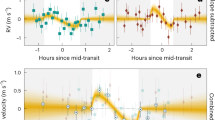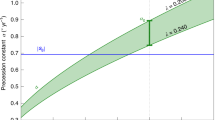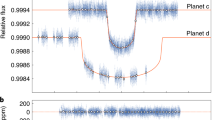Abstract
The angle between the spin of a star and the orbital planes of its planets traces the history of the planetary system. Exoplanets orbiting close to cool stars are expected to be on circular, aligned orbits because of strong tidal interactions with the stellar convective envelope1. Spin–orbit alignment can be measured when the planet transits its star, but such ground-based spectroscopic measurements are challenging for cool, slowly rotating stars2. Here we report the three-dimensional characterization of the trajectory of an exoplanet around an M dwarf star, derived by mapping the spectrum of the stellar photosphere along the chord transited by the planet3. We find that the eccentric orbit of the Neptune-mass exoplanet GJ 436b is nearly perpendicular to the stellar equator. Both eccentricity and misalignment, surprising around a cool star, can result from dynamical interactions (via Kozai migration4) with a yet-undetected outer companion. This inward migration of GJ 436b could have triggered the atmospheric escape that now sustains its giant exosphere5.
This is a preview of subscription content, access via your institution
Access options
Access Nature and 54 other Nature Portfolio journals
Get Nature+, our best-value online-access subscription
$29.99 / 30 days
cancel any time
Subscribe to this journal
Receive 51 print issues and online access
$199.00 per year
only $3.90 per issue
Buy this article
- Purchase on Springer Link
- Instant access to full article PDF
Prices may be subject to local taxes which are calculated during checkout




Similar content being viewed by others
References
Winn, J. N. et al. Hot stars with hot Jupiters have high obliquities. Astrophys. J. 718, L145–L149 (2010)
Lanotte, A. et al. A global analysis of Spitzer and new HARPS data confirms the loneliness and metal-richness of GJ 436 b. Astron. Astrophys. 572, A73 (2014)
Cegla, H. M. et al. The Rossiter-McLaughlin effect reloaded: probing the 3D spin-orbit geometry, differential stellar rotation, and the spatially-resolved stellar spectrum of star-planet systems. Astron. Astrophys. 588, A127 (2016)
Beust, H. et al. Dynamical evolution of the Gliese 436 planetary system. Kozai migration as a potential source for Gliese 436b’s eccentricity. Astron. Astrophys. 545, A88 (2012)
Ehrenreich, D. et al. A giant comet-like cloud of hydrogen escaping the warm Neptune-mass exoplanet GJ 436b. Nature 522, 459–461 (2015)
Mayor, M. et al. Setting new standards with HARPS. Messenger 114, 20–24 (2003)
Cosentino, R. et al. HARPS-N: the new planet hunter at TNG. Proc. SPIE 8446, 84461V (2012)
Knutson, H. A. et al. A Spitzer transmission spectrum for the exoplanet GJ 436b, evidence for stellar variability, and constraints on dayside flux variations. Astrophys. J. 735, 27 (2011)
Bourrier, V. et al. SOPHIE velocimetry of Kepler transit candidates. XVI. Tomographic measurement of the low obliquity of KOI-12b, a warm Jupiter transiting a fast rotator. Astron. Astrophys. 579, A55 (2015)
Albrecht, S. et al. Obliquities of hot Jupiter host stars: evidence for tidal interactions and primordial misalignments. Astrophys. J. 757, 18 (2012)
Butler, R. P. et al. A Neptune-mass planet orbiting the nearby M dwarf GJ 436. Astrophys. J. 617, 580–588 (2004)
Astudillo-Defru, N. et al. Magnetic activity in the HARPS M dwarf sample. The rotation-activity relationship for very low-mass stars through R′(HK). Astron. Astrophys. 600, A13 (2017)
Knutson, H. A. et al. A featureless transmission spectrum for the Neptune-mass exoplanet GJ 436b. Nature 505, 66–68 (2014)
Butler, R. P. et al. The LCES HIRES/Keck Precision Radial Velocity Exoplanet Survey. Astron. J. 153, 208 (2017)
Tong, X. & Zhou, J. Eccentricity modulation of a close-in planet by a companion: application to GJ 436 system. Sci. Chin. Ser. G 52, 640–648 (2009)
Mardling, R. A. On the long-term tidal evolution of GJ 436b in the presence of a resonant companion. Preprint at https://arxiv.org/abs/0805.1928 (2008)
Batygin, K. et al. A quasi-stationary solution to Gliese 436b’s eccentricity. Astrophys. J. 699, 23–30 (2009)
Brothwell, R. D. A window on exoplanet dynamical histories: Rossiter-McLaughlin observations of WASP-13b and WASP-32b. Mon. Not. R. Astron. Soc. 440, 3392–3401 (2014)
Queloz, D. et al. WASP-8b: a retrograde transiting planet in a multiple system. Astron. Astrophys. 517, L1 (2010)
Bourrier, V. et al. Refined architecture of the WASP-8 system: a cautionary tale for traditional Rossiter-McLaughlin analysis. Astron. Astrophys. 599, A33 (2017)
Suárez Mascareño, A. et al. Rotation periods of late-type dwarf stars from time series high-resolution spectroscopy of chromospheric indicators. Mon. Not. R. Astron. Soc. 452, 2745–2756 (2015)
Collier Cameron, A. et al. Line-profile tomography of exoplanet transits—I. The Doppler shadow of HD 189733b. Mon. Not. R. Astron. Soc. 403, 151–158 (2010)
Kreidberg, L. batman: BAsic Transit Model cAlculatioN in Python. Publ. Astron. Soc. Pacif. 127, 1161 (2015)
Bean, J. L. et al. EXOFAST: A Hubble Space Telescope transit light curve for GJ 436b. Astron. Astrophys. 486, 1039 (2008)
Morin, J. et al. Large-scale magnetic topologies of mid M dwarfs. Mon. Not. R. Astron. Soc. 390, 567–581 (2008)
Henry, G. W. Techniques for automated high-precision photometry of Sun-like stars. Publ. Astron. Soc. Pacif. 111, 845 (1999)
Mann, A. W. et al. How to constrain your M dwarf: measuring effective temperature, bolometric luminosity, mass, and radius. Astrophys. J. 804, 64 (2015)
Meibom, S. et al. A spin-down clock for cool stars from observations of a 2.5-billion-year-old cluster. Nature 517, 589–591 (2015)
Barnes, S. A. et al. Rotation periods for cool stars in the 4 Gyr old open cluster M67, the solar-stellar connection, and the applicability of gyrochronology to at least solar age. Astrophys. J. 823, 16 (2016)
Stevenson, K. B. et al. Two nearby sub-Earth-sized exoplanet candidates in the GJ 436 system. Astrophys. J. 755, 9 (2012)
Alonso, R. et al. Limits to the planet candidate GJ 436c. Astron. Astrophys. 487, L5 (2008)
Ballard, S. et al. A search for additional planets in the NASA EPOXI observations of the exoplanet system GJ 436. Astrophys. J. 716, 1047 (2010)
Maciejewski, G. et al. On the GJ 436 planetary system. Acta Astron. 64, 323 (2014)
Hagelberg, J. et al. The Geneva reduction and analysis pipeline for high-contrast imaging of planetary companions. Mon. Not. R. Astron. Soc. 455, 2178–2186 (2016)
Baraffe, I. et al. New evolutionary models for pre-main sequence and main sequence low-mass stars down to the hydrogen-burning limit. Astron. Astrophys. 577, A42 (2015)
Baraffe, I. et al. Evolutionary models for cool brown dwarfs and extrasolar giant planets. The case of HD 209458. Astron. Astrophys. 402, 701 (2003)
Acknowledgements
This work is based on observations made with the HARPS spectrograph on the 3.6 m ESO telescope at the ESO La Silla Observatory, Chile, under GTO program ID 072.C-0488, and with the Italian Telescopio Nazionale Galileo operated on the island of La Palma by the Fundación Galileo Galilei of the INAF (Istituto Nazionale di Astrofisica) at the Spanish Observatorio del Roque de los Muchachos of the Instituto de Astrofisica de Canarias under OPTICON program 16A/049, ‘Sensing Planetary Atmospheres with Differential Echelle Spectroscopy’ (SPADES). OPTICON has received funding from the European Community’s Seventh Framework Programme (FP7/2013-2016) under grant agreement number 312430. This project has also received funding from the European Research Council (ERC) under the European Union’s Horizon 2020 Research and Innovation Programme under grant agreement number 724427 (FOUR ACES). This work was carried out in the framework of the National Centre for Competence in Research ‘PlanetS’ supported by the Swiss National Science Foundation (SNSF). R.A., N.A.-D., V.B., D.E., C.L. and A.W. acknowledge the financial support of the SNSF. H.M.C. gratefully acknowledges support as a CHEOPS Fellow from the SNSF National Centre of Competence in Research ‘PlanetS’. G.W.H. acknowledges long-term support from Tennessee State University and the State of Tennessee through its Centers of Excellence programme. X.B. and X.D. acknowledge the support of CNRS/PNP (Programme national de planétologie). X.B. acknowledges funding from the European Research Council under the ERC Grant Agreement number 337591-ExTrA. We thank C. A. Watson for calculating the convective mass of GJ 436, H. Knutson for facilitating the determination of the stellar rotation period, J.-B. Delisle for discussing the system geometry, and the Telescopio Nazionale Galileo staff for the service observation.
Author information
Authors and Affiliations
Contributions
V.B. coordinated the study of the GJ 436 system, performed the reduction and analysis of the transit data, interpreted the results, and wrote the paper. V.B. and D.E. proposed the original idea. D.E. developed the HARPS-N transit observation programme (led by D.E. and A.W.). V.B., H.M.C. and C.L. developed and refined the reloaded Rossiter–McLaughlin technique. H.B. performed the Kozai simulations and contributed to the interpretation. G.W.H. derived the stellar rotation period from analysis of photometry. N.A.-D. and X.D. derived the stellar rotation period from analysis of activity indices. X.B. and N.A.-D. analysed radial velocity values, and D.S. analysed direct imaging data used to constrain GJ 436c. R.A., H.C., C.L. and A.W. contributed to the analysis and interpretation of the transit data. All authors discussed the results and commented on the manuscript.
Corresponding author
Ethics declarations
Competing interests
The authors declare no competing financial interests.
Additional information
Reviewer Information Nature thanks A. C. Cameron and A. Mann for their contribution to the peer review of this work.
Publisher's note: Springer Nature remains neutral with regard to jurisdictional claims in published maps and institutional affiliations.
Extended data figures and tables
Extended Data Figure 1 Observed and modelled CCF of GJ 436.
a, Typical HARPS-N CCF of GJ 436 (blue points), fitted with a double-Gaussian model (solid black line). This model is the combination of a Gaussian profile for the CCF continuum and lobes plus an inverted Gaussian profile for the CCF core (individual components are plotted as dashed black lines). b, Residuals between the observed CCF and its best fit.
Extended Data Figure 2 Comparison between the properties of the lobe and core Gaussian components of the CCF model.
The panels show the difference between the radial velocity (RV) centroids of the lobe and core components (a), the ratio between their FWHMs (b), and the ratio between their amplitudes (c), as a function of GJ 436b’s orbital phase for each exposure in visit 1 (red), visit 2 (blue) and visit 3 (orange). There is little dispersion of these values around their average in each visit, shown as dashed horizontal lines. Vertical dotted lines are the transit contacts.
Extended Data Figure 3 Correction for the effects of Earth’s atmosphere.
Properties derived from the double-Gaussian fits to the CCFDI are shown before correction (a–c) and after correction of the flux distribution (d–f), as a function of GJ 436b’s orbital phase. The contrast of the CCFDI is shown in a and d, their FWHMs in b and e, and their radial velocities in c and f. Radial velocities are relative to the systemic velocity in each visit, and have been offset by 25 m s−1. They are overplotted with the expected Keplerian radial velocity curve. Visits 1, 2 and 3 are coloured in red, blue and orange, respectively. Vertical dotted lines are the transit contacts; horizontal dashed lines show the average values in each visit.
Extended Data Figure 4 Maps of the residuals between the scaled CCFDI and the  .
.
Residuals are coloured as a function of their flux, and plotted as a function of radial velocity in the stellar rest frame (in abscissa) and orbital phase (in ordinate) for visit 1 (a), visit 2 (b) and visit 3 (c). The vertical and horizontal dashed black lines indicate the mid-transit time and stellar rest velocity, respectively. In-transit residuals correspond to the CCFPO, and show the average stellar line profile (recognizable by a lower flux in the CCFPO cores) from the regions occulted by GJ 436b across the stellar disk. Out-of-transit residuals show little dispersion in all visits, consistent with the low activity of the host star.
Extended Data Figure 5 Properties of the CCFPO as a function of GJ 436b orbital phase.
The contrast (a), FWHM (b), and radial velocity values (c) are derived from the double-Gaussian best fits to the CCFPO, and show similar values over the three nights. a–c, Visits 1, 2 and 3 are coloured in red, blue and orange, respectively. All error bars are 1σ. Horizontal error bars correspond to the exposure time. Vertical dashed lines are the transit contacts. a, b, The width and contrast of the  (horizontal dashed lines) are similar over the three visits. c, The dashed black line is the reloaded Rossiter–McLaughlin model corresponding to the best fit for the planet trajectory and the velocity field of the star.
(horizontal dashed lines) are similar over the three visits. c, The dashed black line is the reloaded Rossiter–McLaughlin model corresponding to the best fit for the planet trajectory and the velocity field of the star.
Extended Data Figure 6 Correlation diagram for the posterior probability distributions of the solid-body rotation model parameters.
Green and blue lines show the two-dimensional confidence regions that contain 39.3% and 86.5% of the accepted steps, respectively. One-dimensional histograms correspond to the distribution projected on the space of each line parameter, with the orange dashed line limiting the 68.3% confidence interval. The red line and white point show median values.
Extended Data Figure 7 Ground-based photometry of GJ 436.
a, Time series of GJ 436 nightly magnitude with transit points removed and normalized to the same seasonal mean. utc, Coordinated Universal time; hjd, heliocentric Julian date. b, Frequency spectrum of the normalized observations with strongest peak at a photometric period of 44.09 days, and secondary peaks corresponding to yearly aliases caused by the temporal sampling. c, Normalized data and best-fit sine curve (blue line) phased to Prot = 44.09 days. The binned data (red squares) highlight the low-level brightness modulation of GJ 436 (peak-to-peak amplitude of 0.0032 mag).
Extended Data Figure 8 Conditions on GJ 436b and GJ 436c orbital planes.
For a given mutual inclination im (vertical axis), the acceptable properties for the orbital planes describe an oval ring in the (Ω, ic) plane. Ω is the difference between the longitudes of the ascending nodes and ic is the orbital inclination of GJ 436c.
Source data
Rights and permissions
About this article
Cite this article
Bourrier, V., Lovis, C., Beust, H. et al. Orbital misalignment of the Neptune-mass exoplanet GJ 436b with the spin of its cool star. Nature 553, 477–480 (2018). https://doi.org/10.1038/nature24677
Received:
Accepted:
Published:
Issue Date:
DOI: https://doi.org/10.1038/nature24677
This article is cited by
-
Stellar masks and bisector’s shape for M-type stars observed in the GAPS programme with HARPS-N at TNG
Experimental Astronomy (2020)
-
Nightside condensation of iron in an ultrahot giant exoplanet
Nature (2020)
Comments
By submitting a comment you agree to abide by our Terms and Community Guidelines. If you find something abusive or that does not comply with our terms or guidelines please flag it as inappropriate.




 .
.